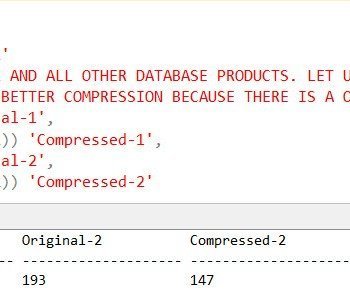 I often find myself teaching mathematics to my daughter, and recently, she has been diving into the realm of Quadratic Equations. As we delved deeper into the subject, we realized that solving quadratic equations by hand and verifying the solutions can be quite cumbersome and time-consuming. Determined to streamline this process, I embarked on a journey to leverage the power of T-SQL for solving quadratic equations. Today, I am excited to share my learnings with all of you. In this blog post, we will explore a practical approach to solving quadratic equations using T-SQL. Let’s dive in!
I often find myself teaching mathematics to my daughter, and recently, she has been diving into the realm of Quadratic Equations. As we delved deeper into the subject, we realized that solving quadratic equations by hand and verifying the solutions can be quite cumbersome and time-consuming. Determined to streamline this process, I embarked on a journey to leverage the power of T-SQL for solving quadratic equations. Today, I am excited to share my learnings with all of you. In this blog post, we will explore a practical approach to solving quadratic equations using T-SQL. Let’s dive in!
Understanding Quadratic Equations
A quadratic equation is typically represented as ax^2 + bx + c = 0, where ‘a’, ‘b’, and ‘c’ are constants, and ‘x’ represents the unknown variable. The goal is to find the values of ‘x’ that satisfy the equation. To solve the quadratic equation, we can use the quadratic formula.
The quadratic formula states that the solutions to the quadratic equation ax^2 + bx + c = 0 can be calculated using the following formula: x = (-b ± √(b^2 – 4ac)) / (2a)
To solve quadratic equations using T-SQL, we can translate the quadratic formula directly into a SQL query. For example, if I have this Equation: x^2 – 5x + 6 = 0:
I can write T-SQL as follows:
DECLARE @a FLOAT, @b FLOAT, @c FLOAT; SET @a = 2; SET @b = -5; SET @c = 3; SELECT x1 = (-@b + SQRT(POWER(@b, 2) - (4 * @a * @c))) / (2 * @a), x2 = (-@b - SQRT(POWER(@b, 2) - (4 * @a * @c))) / (2 * @a);
The above will give a solution as x1 = 1.5 and x2 = 1.
While working with my daughter, we realize that the above equation is not enough as it does not take care of the few situations when the equation is not quadratic or has invalid coefficients. So eventually, we evolved to the following equation.
DECLARE @a FLOAT, @b FLOAT, @c FLOAT;
SET @a = 2;
SET @b = -5;
SET @c = 3;
-- Calculate the discriminant
DECLARE @discriminant FLOAT;
SET @discriminant = POWER(@b, 2) - (4 * @a * @c);
SELECT
x1_result = CASE
WHEN @a = 0 OR @a IS NULL THEN 'Not a quadratic equation'
WHEN @b IS NULL OR @c IS NULL THEN 'Invalid coefficients'
WHEN @discriminant < 0 THEN 'No real solutions'
ELSE 'Real solutions'
END,
x1 = CASE
WHEN @a <> 0 AND @discriminant >= 0 THEN (-@b + SQRT(@discriminant)) / (2 * @a)
ELSE NULL
END,
x2 = CASE
WHEN @a <> 0 AND @discriminant >= 0 THEN (-@b - SQRT(@discriminant)) / (2 * @a)
ELSE NULL
END;I noway claim that my T-SQL solution is 100% correct. I might have missed a few things here and there. Kindly correct me by providing more guidance.
You can always reach out to me on LinkedIn.
Reference: Pinal Dave (https://blog.sqlauthority.com)





